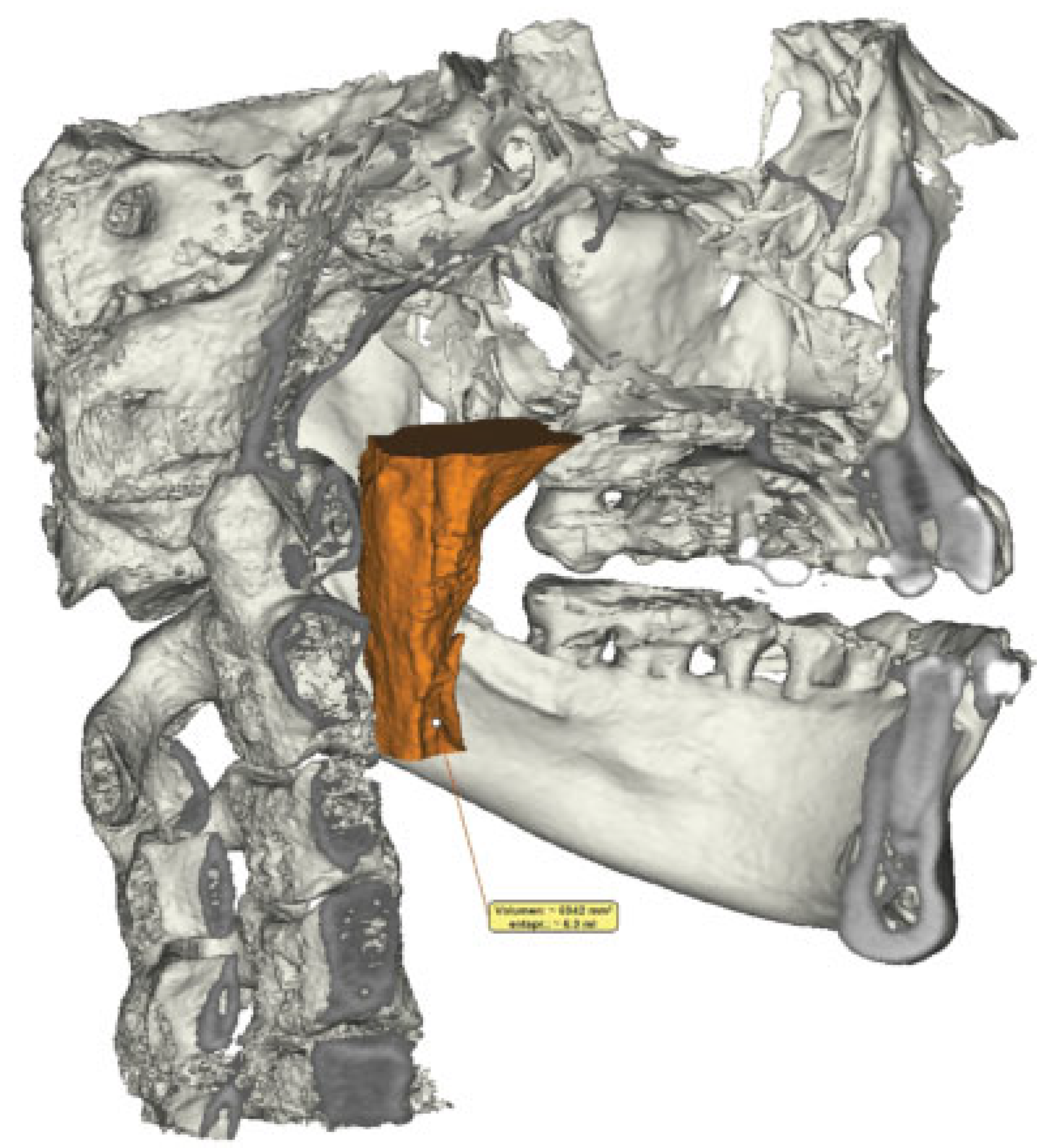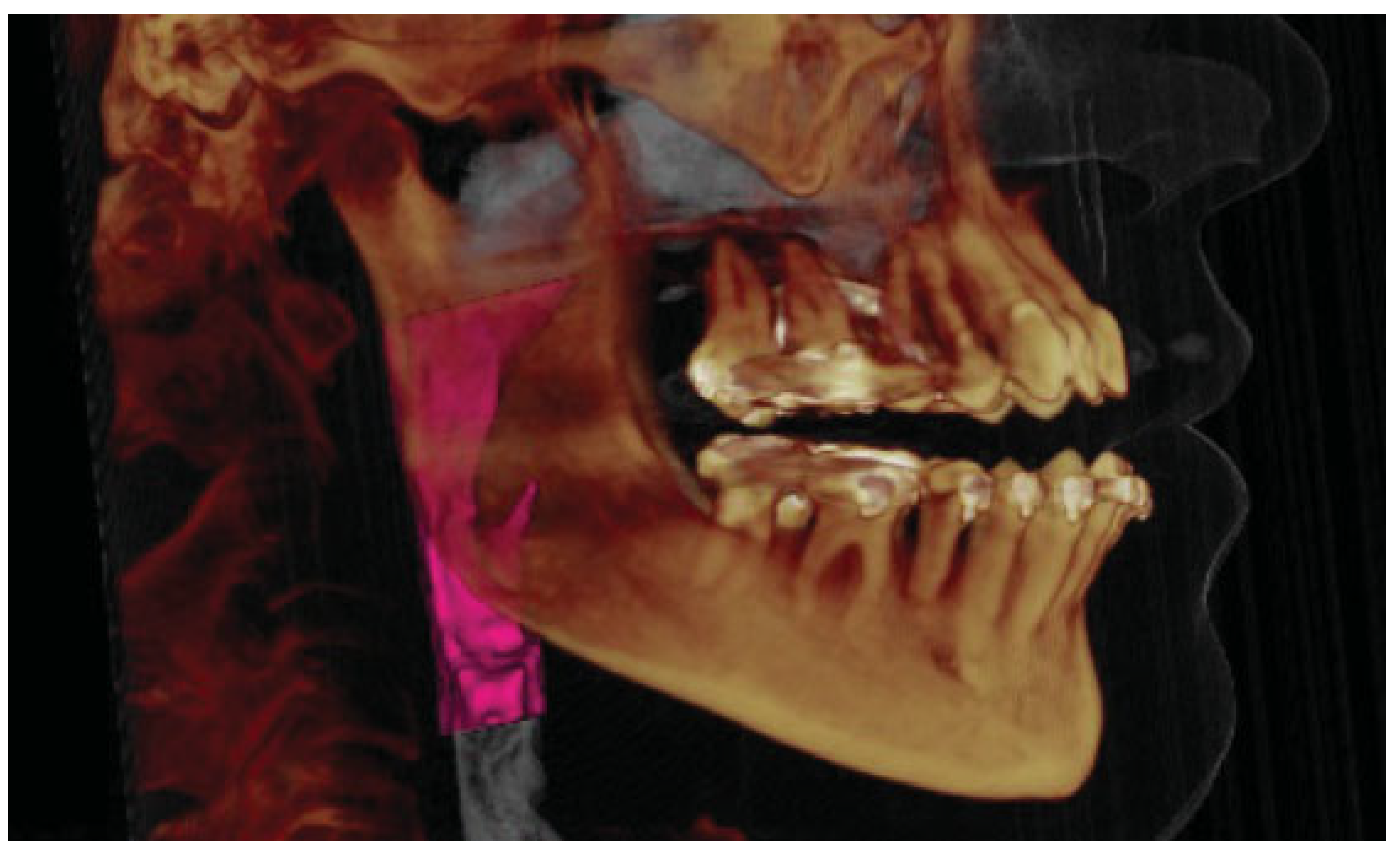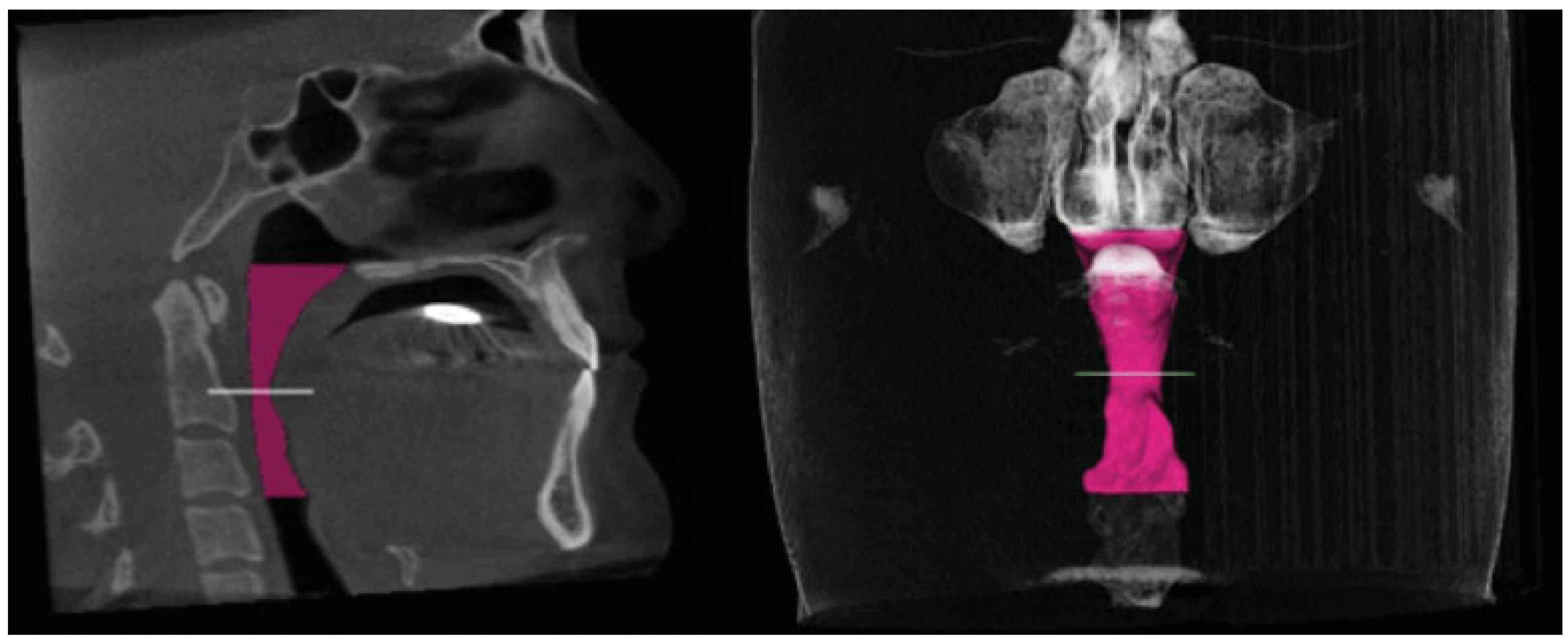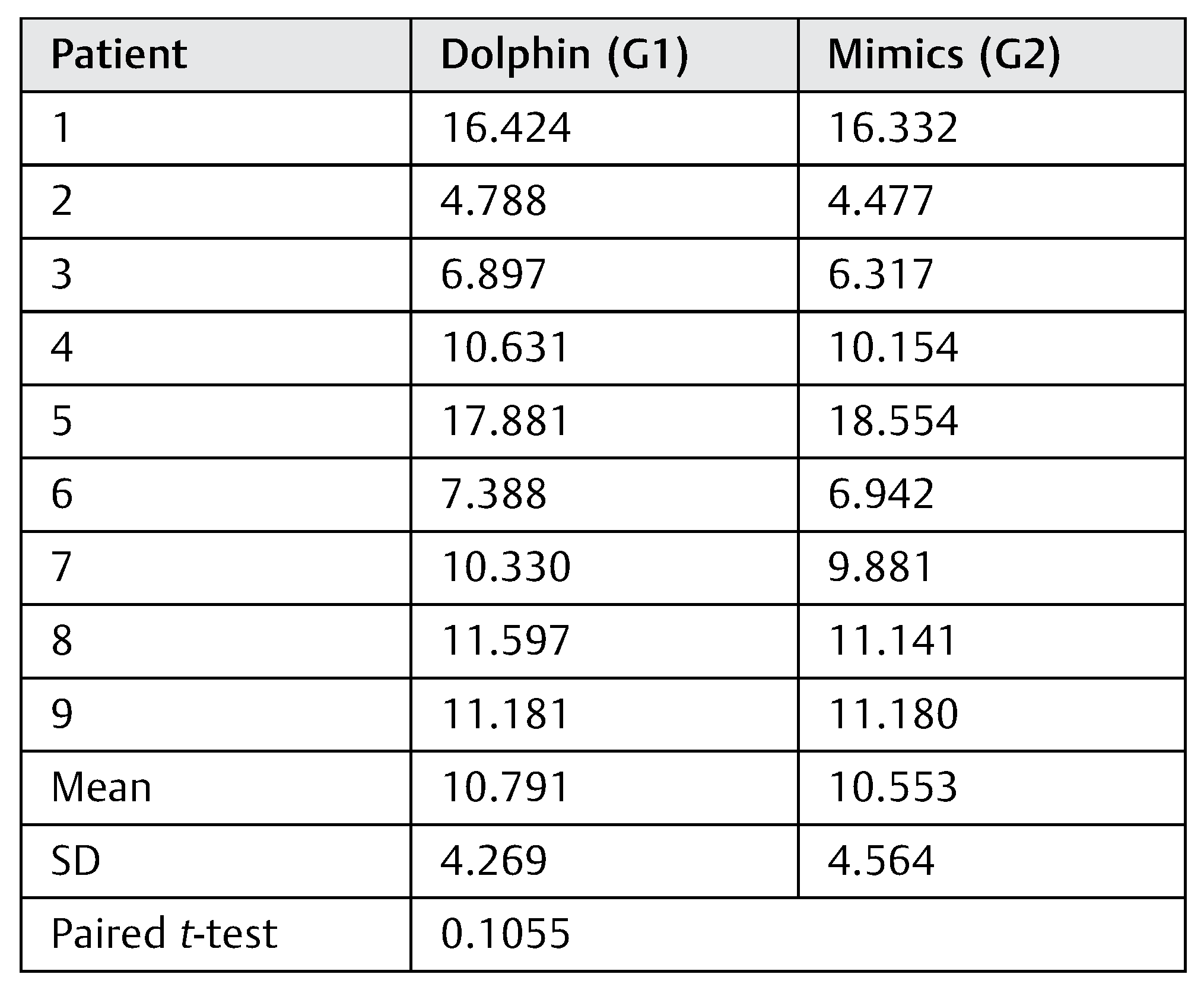Comparison of Imaging Softwares for Upper Airway Evaluation: Preliminary Study
Abstract
:Materials and Methods
Results
Discussion
Acknowledgments
Conflicts of Interests
References
- Hatcher, D.C. Cone beam computed tomography: craniofacial and airway analysis. Dent Clin North Am 2012, 56, 343–357. [Google Scholar] [CrossRef] [PubMed]
- Stratemann, S.; Huang, J.C.; Maki, K.; Hatcher, D.; Miller, A.J. Three-dimensional analysis of the airway with cone-beam computed tomography. Am J Orthod Dentofacial Orthop 2011, 140, 607–615. [Google Scholar] [CrossRef]
- Guijarro-Martínez, R.; Swennen, G.R. Cone-beam computerized tomography imaging and analysis of the upper airway: a systematic review of the literature. Int J Oral Maxillofac Surg 2011, 40, 1227–1237. [Google Scholar] [CrossRef] [PubMed]
- Lenza, M.G.; Lenza, M.M.; Dalstra, M.; Melsen, B.; Cattaneo, P.M. An analysis of different approaches to the assessment of upper airway morphology: a CBCT study. Orthod Craniofac Res 2010, 13, 96–105. [Google Scholar] [CrossRef] [PubMed]
- Güldner, C.; Diogo, I.; Windfuhr, J.; et al. Analysis of the fossa olfactoria using cone beam tomography (CBT). Acta Otolaryngol 2011, 131, 72–78. [Google Scholar] [CrossRef]
- Sutthiprapaporn, P.; Tanimoto, K.; Ohtsuka, M.; Nagasaki, T.; Iida, Y.; Katsumata, A. Positional changes of oropharyngeal structures due to gravity in the upright and supine positions. Dentomaxillofac Radiol 2008, 37, 130–135. [Google Scholar] [CrossRef]
- Guijarro-Martínez, R.; Swennen, G.R. Three-dimensional cone beam computed tomography definition of the anatomical subregions of the upper airway: a validation study. Int J Oral Maxillofac Surg 2013, 42, 1140–1149. [Google Scholar] [CrossRef]
- Burkhard, J.P.; Dietrich, A.D.; Jacobsen, C.; Roos, M.; Lübbers, H.T.; Obwegeser, J.A. Cephalometric and three-dimensional assessment of the posterior airway space and imaging software reliability analysis before and after orthognathic surgery. J Craniomaxillofac Surg 2014, 42, 1428–1436. [Google Scholar] [CrossRef]
- El, H.; Palomo, J.M. Measuring the airway in 3 dimensions: a reliability and accuracy study. Am J Orthod Dentofacial Orthop discussion S50–S52. 2010, 137 (Suppl. 4), 50.e1–50.e9. [Google Scholar] [CrossRef]
- Barkdull, G.C.; Kohl, C.A.; Patel, M.; Davidson, T.M. Computed tomography imaging of patients with obstructive sleep apnea. Laryngoscope 2008, 118, 1486–1492. [Google Scholar] [CrossRef]
- Chen, N.H.; Li, K.K.; Li, S.Y.; et al. Airway assessment by volumetric computed tomography in snorers and subjects with obstructive sleep apnea in a Far-East Asian population (Chinese). Laryngoscope 2002, 112, 721–726. [Google Scholar] [CrossRef]
- Schendel, S.A.; Hatcher, D. Automated 3-dimensional airway analysis from cone-beam computed tomography data. J Oral Maxillofac Surg 2010, 68, 696–701. [Google Scholar] [CrossRef] [PubMed]
- Lascala, C.A.; Panella, J.; Marques, M.M. Analysis of the accuracy of linear measurements obtained by cone beam computed tomography (CBCT-NewTom). Dentomaxillofac Radiol 2004, 33, 291–294. [Google Scholar] [CrossRef] [PubMed]
- Yamashina, A.; Tanimoto, K.; Sutthiprapaporn, P.; Hayakawa, Y. The reliability of computed tomography (CT) values and dimensional measurements of the oropharyngeal region using cone beam CT: comparison with multidetector CT. Dentomaxillofac Radiol 2008, 37, 245–251. [Google Scholar] [CrossRef]
- Olszewska, E.; Sieskiewicz, A.; Rozycki, J.; et al. A comparison of cephalometric analysis using radiographs and craniofacial computed tomography in patients with obstructive sleep apnea syndrome: preliminary report. Eur Arch Otorhinolaryngol 2009, 266, 535–542. [Google Scholar] [CrossRef]
- Cheng, I.; Nilufar, S.; Flores-Mir, C.; Basu, A. Airway segmentation and measurement in CT images. Conf Proc IEEE Eng Med Biol Soc 2007, 2007, 795–799. [Google Scholar]
- Alves, M., Jr.; Franzotti, E.S.; Baratieri, C.; Nunes, L.K.; Nojima, L.I.; Ruellas, A.C. Evaluation of pharyngeal airway space amongst different skeletal patterns. Int J Oral Maxillofac Surg 2012, 41, 814–819. [Google Scholar] [CrossRef]
- Muto, T.; Takeda, S.; Kanazawa, M.; Yamazaki, A.; Fujiwara, Y.; Mizoguchi, I. The effect of head posture on the pharyngeal airway space (PAS). Int J Oral Maxillofac Surg 2002, 31, 579–583. [Google Scholar] [CrossRef]
- Ghoneima, A.; Kula, K. Accuracy and reliability of cone-beam computed tomography for airway volume analysis. Eur J Orthod 2013, 35, 256–261. [Google Scholar] [CrossRef]
- Castro-Silva, L.; Monnazzi, M.S.; Spin-Neto, R.; et al. Cone-beam evaluation of pharyngeal airway space in class I, II, and III patients. Oral Surg Oral Med Oral Pathol Oral Radiol 2015, 120, 679–683. [Google Scholar] [CrossRef]
- El-Beialy, A.R.; Fayed, M.S.; El-Bialy, A.M.; Mostafa, Y.A. Accuracy and reliability of cone-beam computed tomography measurements: influence of head orientation. Am J Orthod Dentofacial Orthop 2011, 140, 157–165. [Google Scholar] [CrossRef] [PubMed]
- Smith, J.D.; Thomas, P.M.; Proffit, W.R. A comparison of current prediction imaging programs. Am J Orthod Dentofacial Orthop 2004, 125, 527–536. [Google Scholar] [CrossRef]




 |
© 2017 by the author. The Author(s) 2017.
Share and Cite
dos Santos Trento, G.; Moura, L.B.; Spin-Neto, R.; Jürgens, P.C.; Aparecida Cabrini Gabrielli, M.; Pereira-Filho, V.A. Comparison of Imaging Softwares for Upper Airway Evaluation: Preliminary Study. Craniomaxillofac. Trauma Reconstr. 2018, 11, 273-277. https://doi.org/10.1055/s-0037-1606247
dos Santos Trento G, Moura LB, Spin-Neto R, Jürgens PC, Aparecida Cabrini Gabrielli M, Pereira-Filho VA. Comparison of Imaging Softwares for Upper Airway Evaluation: Preliminary Study. Craniomaxillofacial Trauma & Reconstruction. 2018; 11(4):273-277. https://doi.org/10.1055/s-0037-1606247
Chicago/Turabian Styledos Santos Trento, Guilherme, Lucas Borin Moura, Rubens Spin-Neto, Philipp Christian Jürgens, Marisa Aparecida Cabrini Gabrielli, and Valfrido Antônio Pereira-Filho. 2018. "Comparison of Imaging Softwares for Upper Airway Evaluation: Preliminary Study" Craniomaxillofacial Trauma & Reconstruction 11, no. 4: 273-277. https://doi.org/10.1055/s-0037-1606247
APA Styledos Santos Trento, G., Moura, L. B., Spin-Neto, R., Jürgens, P. C., Aparecida Cabrini Gabrielli, M., & Pereira-Filho, V. A. (2018). Comparison of Imaging Softwares for Upper Airway Evaluation: Preliminary Study. Craniomaxillofacial Trauma & Reconstruction, 11(4), 273-277. https://doi.org/10.1055/s-0037-1606247



